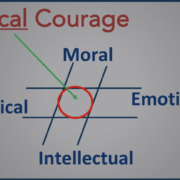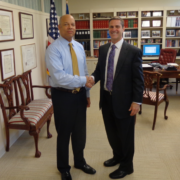Radical Courage: How Leaders Maintain the Balance to Win
Radical Courage: How Leaders Maintain the Balance to Win
Digital technology intensifies competition for small businesses and nonprofits. This, in turn, places extraordinary demands on leaders and teams.
Sadly, many leaders fail under the pressure. We see the news stories every day, from Uber to United to Oxfam — the list goes on. These are only the most visible examples.
What do leaders need to thrive in the digital age? Radical Courage.
Radical Courage is the integration of the four main types of courage: physical, moral, emotional, and intellectual. I use the descriptor “Radical” to express an idea both basic and profound — leaders require multiple forms of courage.
“Courage,” Winston Churchill argued, “is rightly esteemed the first of human qualities because it has been said, it is the quality which guarantees all others.”
Ancient Greek philosopher Aristotle described virtues such as courage as the mean between extremes. This golden mean, he argued, exists between excess and deficiency. In the case of courage, it is a mean between recklessness and cowardice
The U.S. Army identifies two types of courage: physical and moral. Physical courage means doing one’s duty despite fear of death or harm. Bravery on the battlefield, for instance, is a necessity for soldiers. Without it, units and armies could collapse when engaged with the enemy.
Many small businesses and nonprofits are engaged in tough and demanding work, too. Some operate in dangerous situations. A leader’s willingness to share hardship and difficulty — to set the example — is an important aspect of physical courage.
Moral courage, on the other hand, means to stand up for what is morally and/or ethically right despite pressure to do otherwise. Such pressure can come from leaders or peers; it can also come from wanting to avoid responsibility for mistakes or errors. Moral courage within an organization’s leadership is essential for building internal trust. It also builds public trust in the organization.
The decision by some Volkswagen managers to falsify emissions test results, compounded by senior executive decisions to cover up the cheating, are examples of poor moral courage. Small business and nonprofit leaders face these kinds of challenges all the time, particularly over accounting, regulations, and reports. Leaders must set the right example here, as well.
The third strand of courage is emotional. In Aristotelian terms, emotional courage can be seen as a mean between the extremes of cold-heartedness and excessive passion. Maintaining a balance between ignoring or avoiding emotionally difficult situations and being carried away by them is important for leaders.
Leaders may face emotionally challenging situations with customers, colleagues, or the public that create high levels of anxiety and trepidation. Such situations carry the risk of professional harm or damage to the business if not handled right. Leaders with emotional courage tackle these high anxiety situations rather than pawning them off on others.
A powerful example of emotional courage comes from my former executive officer in Afghanistan, Major Chris Doneski. An explosion during a July 2007 firefight killed a beloved officer, Captain Tom Bostick. The blast inflicted horrific damage. When Tom’s remains were evacuated to the field hospital at our main base, Chris Doneski was the senior leader on site. Someone needed to identify Tom’s remains for the doctor’s report. Chris could have directed a junior officer or senior noncommissioned officer to perform the gruesome task. Chris knew that he needed to do it himself. He will never unsee what he saw that day.
Intellectual courage is the final type — and the least understood. The U.S. Army fails to include intellectual courage in its concept of courage. The U.S. Marine Corps, however, describes “mental” courage as the ability “to make tough decisions under stress and pressure.”
This is an important addition, but the definition is not necessarily helpful. How does a leader know if the decision in a tough situation is the right one? How do leaders know when to stick to their guns and when to make changes?
Intellectual courage is the willingness to make sound decisions in an uncertain and complex situation when the best choice is not obvious.
Like other virtues, intellectual courage is a balance. This balance can take on many dimensions. The one depicted on the picture below is a balance between strength of conviction one side and open-mindedness on the other.

Think about it. If a leader is imbalanced on strength of conviction, they can become obstinate, bull-headed, and believe in their own propaganda — hubris, the ancient Greeks said, precedes a fall.
On the other hand, leaders can become so open-minded and flexible that they lose the courage to act in the face of uncertainty and complexity. Others create hyperactivity by reacting to every conflicting or contradictory point. Both problems can be fatal.
Another balance is between decisiveness and deliberation. Impulsive leaders make decisions on instinct and insufficient information, which can lead organization in the wrong direction very rapidly.
Excessively deliberative leaders, on the other hand, delay decision-making by constantly seeking more data and analysis — even if more information is not needed for the decision. This process goes on until the bad and less bad options become obvious. The leader decides for the less bad and brags about making the right choice. The incessant deliberating, however, has resulted in many lost opportunities to shape more positive outcomes.
Sustaining balance between these kinds of extremes is the foundation of good judgment. Such balance does not come naturally to most people, so it must be developed and nurtured.
Radical Courage is the integration of these four types of courage. Imagine a hashtag. It has two vertical lines and two horizontal lines. Each line represents a type of courage: physical, moral, emotional, and intellectual. Radical Courage occupies the space in the center.

This depiction is more useful than the intersection of four lines. That description implies an unrealistic and inflexible point of perfect balance.
Leaders often grapple with situations requiring more than one aspect of courage. The center space of the hashtag allows for movement, for judgment, and for finding different points of balance.
Leaders who can do this move from good to great.









